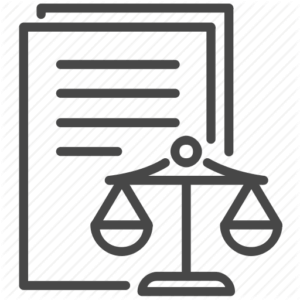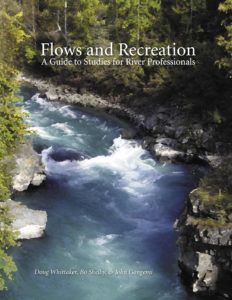Unlocking the Future of Yuba River Salmon: Advocating for Restoration Through Relicensing
On January 16th, SYRCL and our allies in the Foothills Water Network filed comments with the Federal Energy Commission (FERC) requesting formal studies to help restore salmon in the lower Yuba River. Our comments also focused on the YWA’s Final License Application for the project and are part of the relicensing of the Narrows 1 Project located on the lower Yuba River.
What is “Relicensing”?
The Federal Energy Commission (FERC) is charged with the licensing of non-federal hydroelectric dams. These legally binding licenses compel (or require) dam operators to meet certain conditions on the river and may include additional conditions such as recreational access, minimum river flows, and monitoring fish.
Many of our dams were built before modern environmental laws, and the license conditions at that time did not consider native fisheries, recreational uses, or the negative impacts associated with dam operations. As these licenses were issued for 40-50 year lifespans, many of the hydro projects in the Yuba watershed are still operating under licenses and conditions that were developed when the dam was built.1
Given that these licenses can last up to 50 years, relicensing is a once-in-a-lifetime opportunity to look at how the dam is operated and negotiate conditions that can mitigate hydroelectric operations and help restore flows and habitat for the fishery. Relicensing can help ensure that our water resources are managed in a way that balances hydro generation with the long-term health and resilience of our rivers and ecosystems.
Englebright Dam and Narrows 1
SYRCL is now engaged in a relicensing proceeding on the Narrows 1 Project that includes a powerhouse and associated infrastructure that utilizes water from the Englebright Reservoir. Initially owned by PG&E, the original Narrows license was issued in 1966; however, the license was transferred to Yuba Water Agency in 2023 and is now set to expire on January 31, 2026.
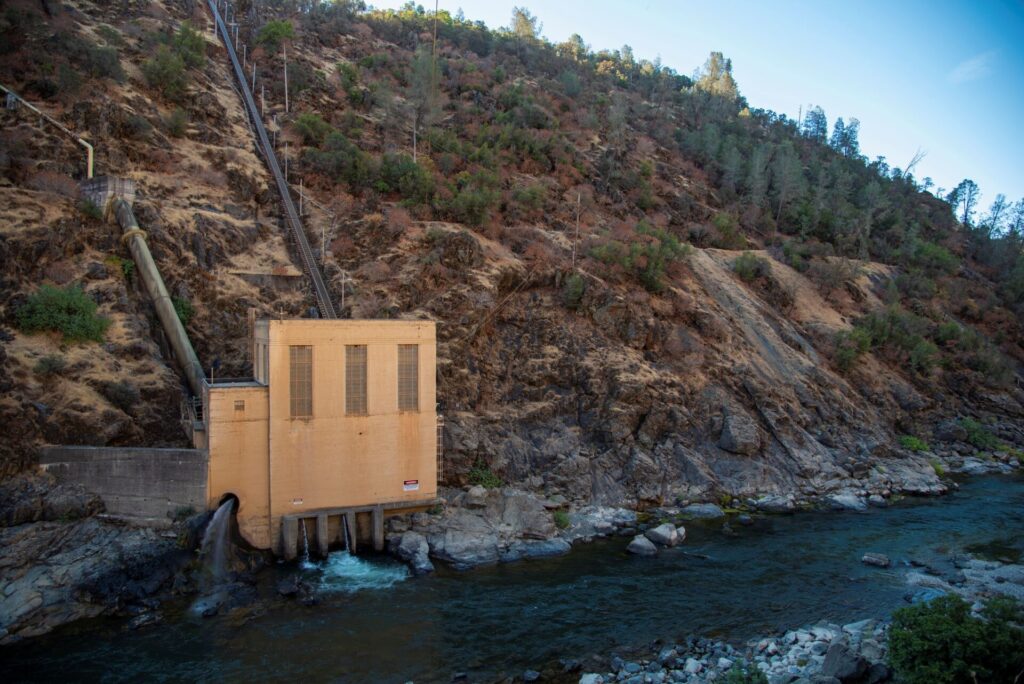
Englebright Dam was originally constructed on the Yuba River as a debris dam – it was meant to catch sediment and mining debris, but now its main function is for lake recreation and hydropower generation. Englebright does not provide any flood protection.
Englebright Dam is a towering structure of 260 feet on the Yuba River that blocks access to many miles of upstream habitat that previously hosted the spawning of tens of thousands of salmon. The dam’s hydroelectric operations disrupt the natural flow of water, which has significant impacts downstream. Increased flows during the summer months to meet irrigation and power demands, and lower flows especially during early fall storms conflict with the natural hydrologic pattern native fish evolved with. Additional impacts from Englebright Dam, and most dams, include preventing the downstream movement of sediment, nutrients, and large wood which is an important component of rearing habitat.
Currently, the only way for water to exit Englebright reservoir is through the two outlets used for hydropower electricity generation, Narrows 1 and Narrows 2 (not being considered through this process). During high water events water will also spill over the dam’s rim, which is part of the dam’s design. Both power outlets are under the ownership, operation, and maintenance of the Yuba Water Agency (YWA).
The Yuba River Development Project: Studies reveal negative impacts to downstream habitat
Beginning in 2006, SYRCL worked with our allies at the Foothills Water Network on a collaborative proceeding to relicense YWA’s Yuba River Development Project (YRDP). As part of the relicensing process, SYRCL advocated for studies to better understand the impacts of Narrows 2 (the other outlet on Englebright) and upstream hydroelectric projects on the North Yuba, Oregon Creek, and Middle Yuba, including New Bullards Bar – collectively known as YRDP. These studies were used to help guide license conditions and measures to mitigate the impact of the full hydroelectric projects. One critical study that came out of this process was an understanding of the impacts of the Narrows 2 outlet on the downstream habitat in the Lower Yuba.
At issue is the fact that the two existing outlets (Narrows 1 and 2) can’t release enough water to inundate the floodplains of the lower Yuba River. The current combined capacity of the outlets is just over 4,000 cfs, but the release needs to be about 5,000 cfs to inundate the floodplains.
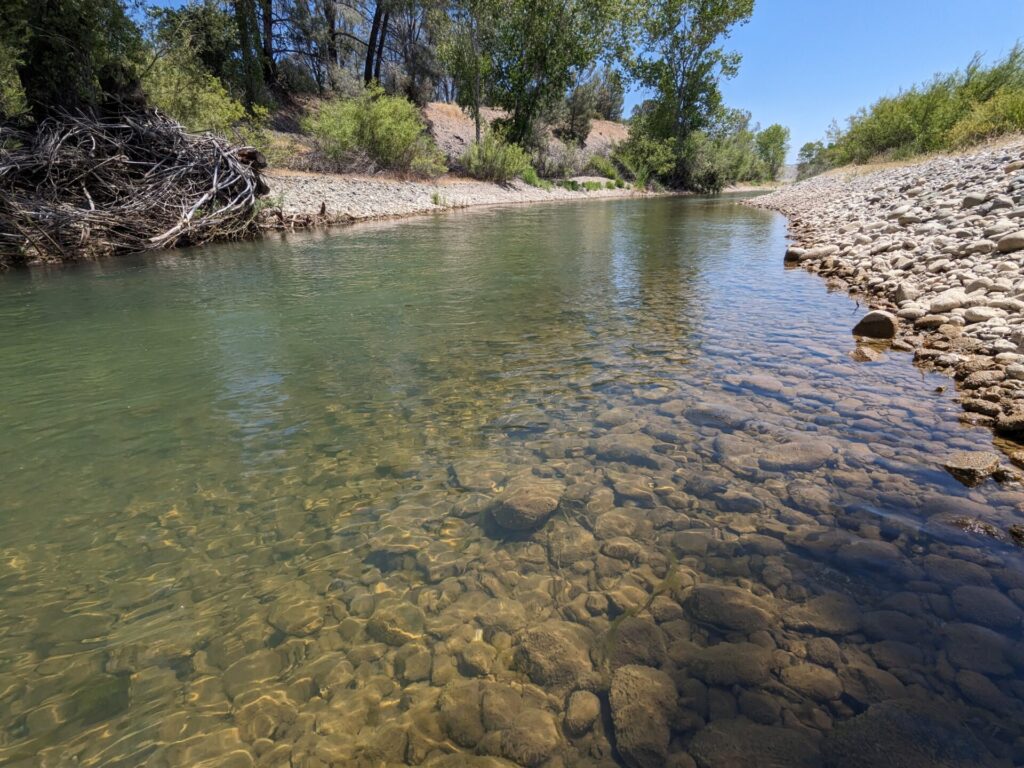
The Lower Long Bar Restoration Project — Completed November, 2022. SYRCL is confident that with this restoration, much needed rearing habitat in the lower Yuba River will be re-established. With this, a better future for spring- and fall-run Chinook and Central Valley Steelhead is possible and the overall health of the river is enhanced.
Without flooding, the vegetation and habitat along the riverbanks struggles to grow. That habitat is necessary for the growth of young Chinook salmon and steelhead. For these fish to fully benefit, the floodplains need to be flooded for ideally 21 days. According to the modeling and studies that were completed during YRDP, this happens about once every three years. The limitations of the outlets means that the current regulatory flows are not enough to restore habitat or benefit salmon.
However, those studies and conclusions were part of the YRDP relicensing process and focused on the environmental impacts of only those YRDP projects, including Narrows 2. Narrows 1 is a wholly different project and relicensing proceeding. FERC sees these as different projects. The Narrows 1 relicensing is therefore an opportunity to once again make the case for flows for salmon in the Lower Yuba.
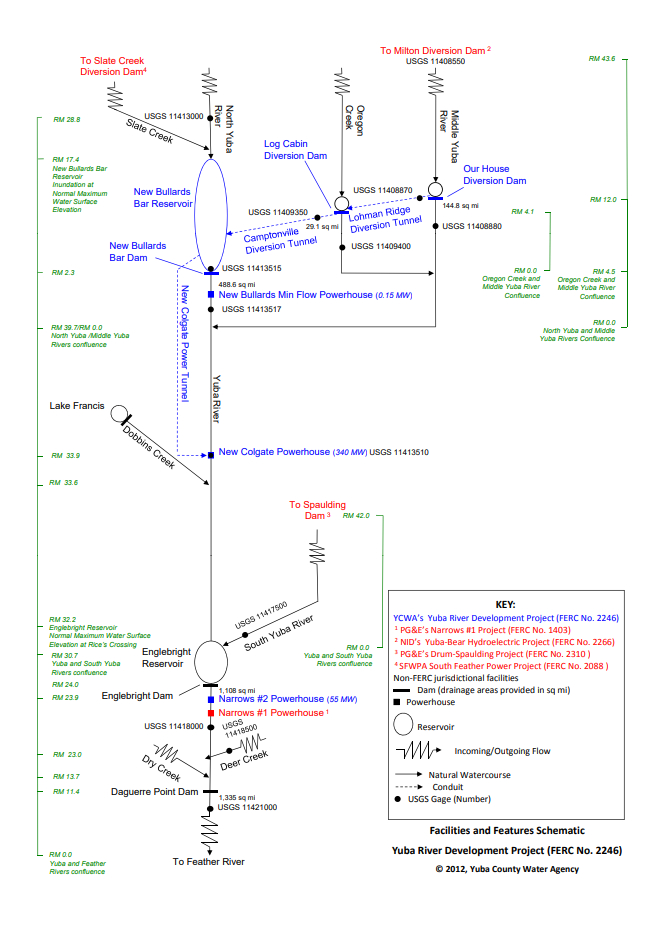
This schematic shows the YRDP hydrolelectric projects. Projects in blue are owned by YWA and are part of YRDP. Narrows 1 is red, since it’s not in the project. YWA now owns and operates Narrows 1.
In our comments, SYRCL has asked that YWA study adding more infrastructure (such as another pipe or outlet) so that sufficient water can be released in a controlled manner and inundate the lower Yuba floodplain. SYRCL has also raised other issues about water temperature, monitoring juvenile outmigration, safe and legal river access to the Narrows Canyon below Englebright, and how quickly the reservoir is filling with sediment, its designed purpose.
Englebright Dam is part of the project and under FERC jurisdiction
In our comments, we urged the Federal Energy Regulatory Commission (FERC) to recognize and include Englebright Dam as a crucial and integral part of the project.
The operation of the Narrows projects rely heavily on the water from Englebright. If the dam were removed or changed, significant adjustments would be needed for the project to continue its operation and power generation. Despite the dam being owned by the U.S. Army Corps of Engineers (USACE), it is operated entirely by Yuba Water Agency, which also holds the sole water rights for the dam. The State Water Resources Control Board (SWRCB) and the USACE recognize that the primary purpose of Englebright Dam and Reservoir is now power generation.
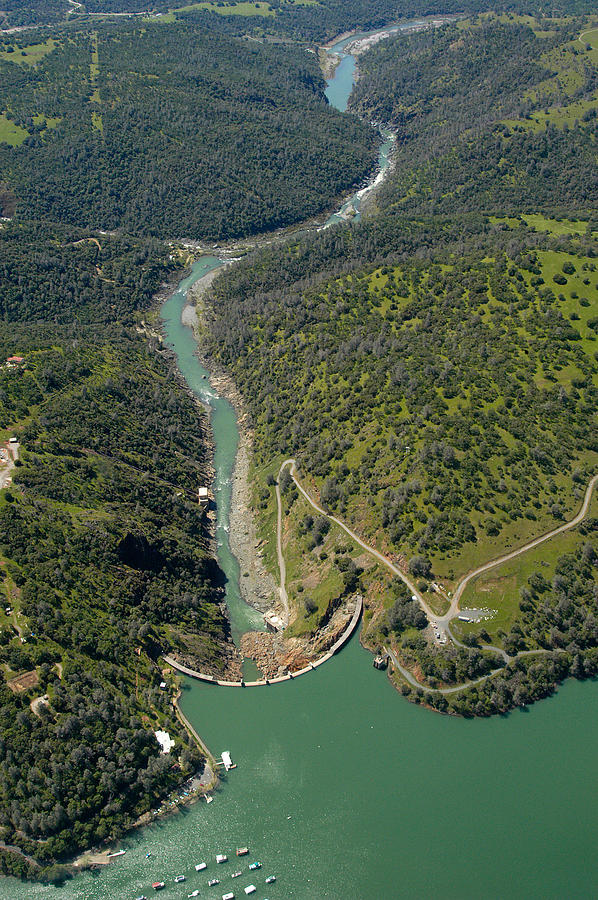
Narrows 1 is on river left, about 1,500 feet downstream from Englebright Dam. An intake 40 feet deep in the reservoir connects to a tunnel that pipes water to the powerhouse. Narrows 2 is located near the base of the dam.
Next steps in relicensing
FERC is now considering our study request plus additional information requests and comments from SYRCL, state and federal agencies, and other stakeholders. FERC may ask for additional information and studies from YWA. The next big step is the environmental review of the impacts of the proposed license. According to the timeline, FERC may issue a scoping document in the Spring.
Learn more:
Read SYRCL and FWN’s study requests and comments (link to SYRCL Narrow comments) FWN comments Narrows FLA final 1.16.24.pdf
Learn more about Narrows relicensing (link to YWA relicensing website): Narrows Relicensing | Yuba Water Agency, CA
Since 2007, SYRCL has worked in several collaborative relicensing proceedings in the Yuba and Bear watersheds. Learn more: Dams and Hydropower • SYRCL (yubariver.org)
- Fast facts about Hydropower Projects on the Yuba:
Many of the hydroelectric dams on the Yuba are still operating under license requirements and conditions that were issued in the 1960s, long before the advent of our modern environmental laws. Given that licenses are good for 40-50 years, these projects are operating with those same original requirements and conditions, with automatic annual extensions granted by FERC.
– Narrows 1 Project (1966) Originally owned by PG&E, the license was issued in 1966; however, the license was transferred to YWA in 2023 and is now set to expire on January 31, 2026. SYRCL is currently working on the relicensing of Narrows. Narrows Relicensing | Yuba Water Agency, CA
– Yuba Bear Hydroelectric Project (1963) FERC granted the Yuba Bear license to the Nevada Irrigation District in 1963, which expired in April of 2013 and has been operating on annual renewals since then. (FERC) Project No. 2266 / Yuba-Bear Hydroelectric Project| California State Water Resources Control Board
– Yuba River Development Project (1963) YWA’s YRDP was initially licensed in May 1963. The original license term expired in 2016, and since that time, FERC has allowed the project to operate under the same license conditions until FERC issues a new license. Yuba River Development Project | California State Water Resources Control Board
– Drum Spalding Hydroelectric Project (1963) The Drum Project license was issued in June of 1963 and expired on April 30, 2013. Hyperlink: FERC 2310 and 14531/Drum-Spaulding Project | California State Water Resources Control Board ↩︎
This post originally appeared on SYRCL.

